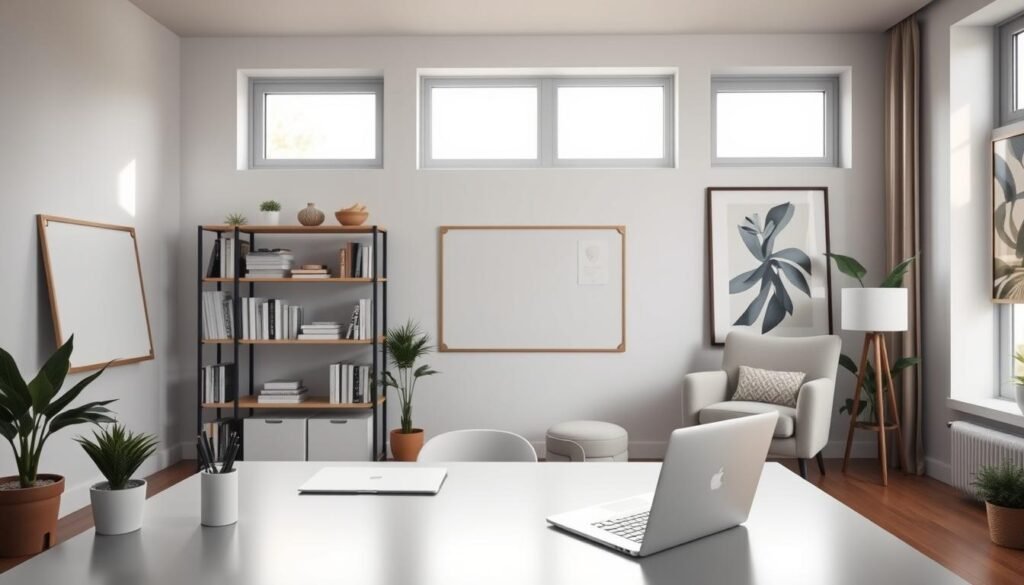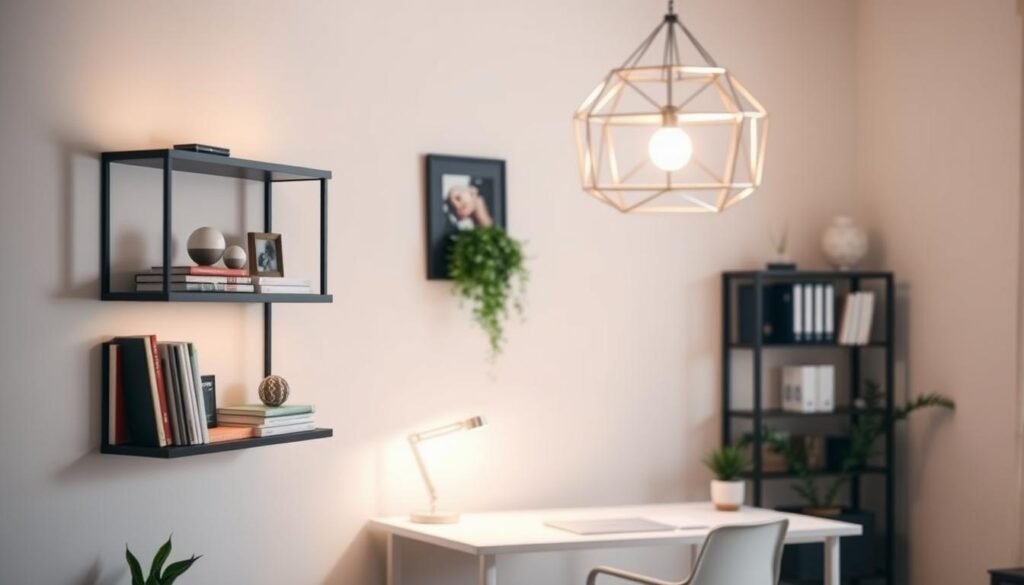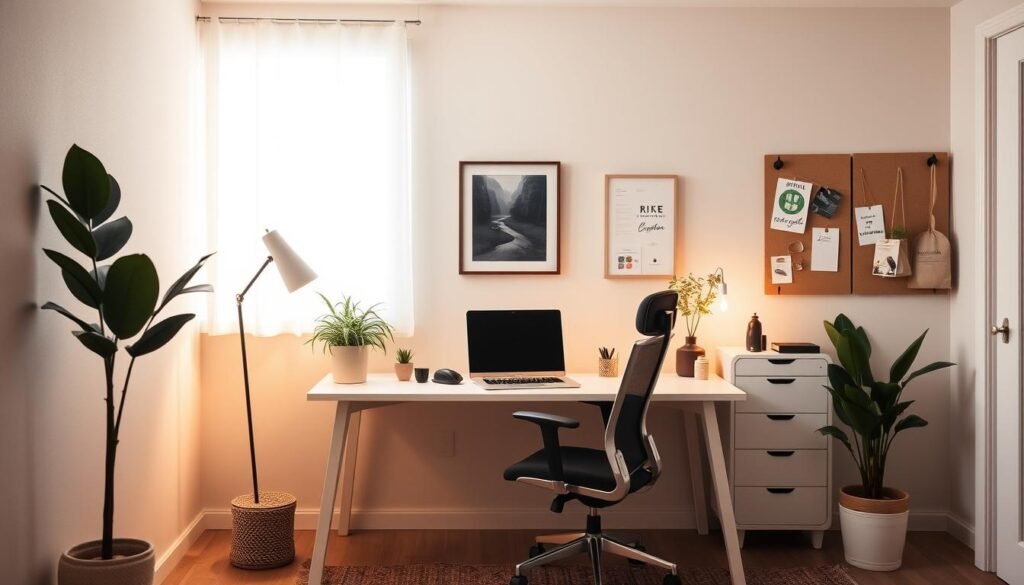Transforming a basic workspace into a polished, professional environment doesn’t require endless cash. With a little creativity and IKEA’s versatile furniture, you can craft a luxury-inspired setup that feels custom-designed. This guide reveals clever upgrades for desks, storage, and decor—all achievable with simple tools and affordable materials.
Say goodbye to bland workstations. These hacks turn ordinary items like tabletops, shelving units, and cabinets into statement pieces that balance elegance and practicality. Whether you’re working with tight spaces or craving a minimalist aesthetic, these ideas adapt to your needs.
We’ve curated 12 transformative projects that prioritize both style and function. From floating desk designs to hidden cable management systems, each solution maximizes your budget without cutting corners. Discover how to blend textures, colors, and smart organization for a workspace that sparks productivity.
Key Takeaways
- Create designer-inspired workspaces using affordable IKEA staples
- Customize furniture with paint, hardware, or modular add-ons
- Optimize small spaces through vertical storage solutions
- Boost productivity with ergonomic and visually calming layouts
- Achieve high-end finishes using budget-friendly materials like contact paper or trim
- Hide cords and clutter with integrated organizational systems
Introduction: Embracing a Chic, Budget Home Office
Crafting a workspace that inspires doesn’t demand a designer budget—just smart strategies and adaptable tools. With hybrid work models now standard, your environment directly impacts focus and creativity. Interior experts agree: “Spaces that spark joy sharpen your mindset and output.”
Why Personalized Workspaces Matter
Gone are the days of makeshift kitchen-table setups. A dedicated area for professional tasks helps separate work hours from personal time. This shift isn’t about square footage—it’s about intentional design that mirrors your workflow.
Building Smart with IKEA Foundations
IKEA’s modular systems let you mix-and-match components like building blocks. Their furniture adapts to quirks—awkward corners, limited walls, or evolving tech needs. Best part? Affordable prices mean you can test layouts before committing.
Think of their pieces as blank canvases. Add paint, legs, or hardware to transform basic shelves into sleek storage units. One user turned a $50 Lack table into a floating desk with hidden charging stations. That’s the power of customization.
“Your workspace should grow with your career—not hold it back.”
Essential Elements for a DIY Home Office
Building a polished work environment starts with four non-negotiable components. These core elements transform chaotic corners into productivity hubs, whether you’re crunching numbers or brainstorming campaigns.
Work Surface Meets Smart Organization
Interior designer Katie Schroder puts it simply:
“A spacious desk acts as your mission control, while hidden storage keeps visual noise at bay.”
Opt for surfaces deep enough for dual monitors yet streamlined to prevent clutter buildup. Pair with cabinets that swallow printers and paperwork whole.
Vertical storage solutions maximize limited square footage. Open shelves display style-forward accessories, while closed units conceal less photogenic essentials. This balance maintains breathable energy in your office space.
Zoe Feldman emphasizes two often-overlooked heroes: task lighting and supportive seating. “Overhead fixtures cast harsh shadows,” she notes. “Layer adjustable lamps where you read contracts.” Your chair? Treat it like a coworker—one that actively supports your spine during marathon sessions.
When these pieces click together, magic happens. You get a workspace that functions like a tailored suit—sharp where it counts, comfortable where it matters.
IKEA Hacks: Innovative Ideas for a Budget Workspace
Unlocking the hidden potential of IKEA’s catalog requires seeing furniture through a creative lens. Their modular designs become building blocks for elevated workstations when paired with strategic upgrades.
Repurposing IKEA Cabinets and Shelving
The SEKTION kitchen system shines beyond meal prep zones. Wall-mounted cabinets double as floating desks when anchored to studs, while base units with casters become mobile file storage. One designer combined 18″ and 24″ depths to craft a built-in look for a client’s corner office.
Five sheets of plywood transformed basic shelves into a floor-to-ceiling storage wall. This project used IKEA’s standardized measurements to integrate custom cubbies for binders and tech accessories. Pro tip: Add crown molding to bridge gaps between units and ceilings.
Customizing Countertops and Tables for Style
IKEA’s glue-laminated kitchen countertops solve two problems: affordable durability and instant sophistication. Four slabs became a 12-foot L-shaped desk in a recent makeover. Though heavy, their seamless appearance rivals high-end furniture.
Pair these surfaces with hairpin legs or adjustable table frames for ergonomic flexibility. One user stained a birch countertop to match vintage decor, proving basic materials can adapt to any design vision. Hardware swaps complete the transformation—try leather pulls for warmth or matte black knobs for contrast.
Designing Your Home Office: From Concept to Execution
Great design starts with a tape measure and a clear vision. Before grabbing tools or paint samples, map your room’s potential by understanding its limits and opportunities. Melissa Oholendt of Oho Interiors advises: “An 8×10 foot area works for built-in desks, while 10×13 feet allows floating furniture with hidden storage.”

Planning the Space and Measuring Accurately
Start by sketching your room’s dimensions. Note window placements, outlet locations, and door swings—these details determine where furniture fits comfortably. Free digital tools like Planner 5D help test layouts without moving heavy cabinets.
Vertical storage becomes your ally in tight spaces. Floor-to-ceiling shelving units hold supplies without eating into desk real estate. One user transformed a 6-foot wall into a command center using IKEA’s BILLY bookcases and adjustable brackets.
Consider workflow when positioning essentials. Keep daily tools within arm’s reach, storing seasonal items higher up. Awkward nooks? Turn them into charging stations or plant displays. One designer converted a sloped attic corner into a cozy reading spot beside a floating desk.
“Measure twice, cut once—but plan seven times. Your future self will thank you.”
Step-by-Step DIY Assembly Guide
Mastering precision cuts and finishes turns basic materials into polished office components. Let’s break down the process for creating custom storage walls or desks using simple woodworking techniques.
Preparing, Cutting, and Assembling Plywood
Start by marking measurements directly on panels using painter’s tape. For long cuts, clamp a straight board as a parallel guide. This keeps circular saw lines crisp. Track saws handle wide cross-cuts efficiently, while chopsaws tackle smaller pieces.
| Tool | Use Case | Pro Tip |
|---|---|---|
| Circular Saw | Straight-line ripping | Use sacrificial boards beneath panels |
| Track Saw | Precision cross-cutting | Secure material with clamps |
| Chopsaw | Short repeat cuts | Check blade alignment first |
| Wood Filler | Edge smoothing | Apply in thin layers |
| Primer | Surface prep | Sand lightly between coats |
Priming, Painting, and Finishing Touches
Fill plywood edges with wood filler before sanding. Wipe surfaces with tack cloth to remove dust. Use oil-based primer to prevent grain swelling. Two thin coats beat one thick layer every time.
For glossy finishes, roll paint vertically first, then horizontally. Let each coat dry 4-6 hours. Lightly sand between applications using 220-grit paper. This removes imperfections without damaging layers beneath.
Assemble pieces only after paint fully cures—usually 48 hours. Slightly undersized shelves slide smoothly into cabinets. Remember: patience here prevents headaches later.
Maximizing Functionality with Smart Storage and Lighting
A clutter-free workspace begins with clever storage paired with strategic illumination. Thoughtful organization reduces visual noise, while layered lighting keeps your eyes fresh during deadlines.

Storage That Works Smarter
Built-in compartments transform ordinary shelves into multitaskers. Try pull-out drawers under desks for notebooks or vertical files. One designer notes: “Reserve lower cabinets for printers—easy access without the bulk.” Magnetic panels behind monitors hold notes, keeping essentials visible yet tidy.
For cables, drill discreet holes near outlets. Adhesive hooks under surfaces guide cords neatly. This approach hides wires while keeping chargers within reach—no more hunting under furniture.
Lighting Layers That Adapt
Combine three types for optimal results:
- Ambient: Overhead fixtures with dimmers
- Task: Adjustable desk lamps
- Accent: LED strips under shelves
LED options shine here. Stick flexible strips inside glass cabinets for a high-end glow. Choose warm tones for video calls or cool whites for detail work. As one remote worker shared: “My $15 under-desk lights make Zoom meetings look pro.”
Remember—your setup should evolve. Test storage heights and lamp angles until everything feels effortless. When form meets function, productivity follows naturally.
Transforming Unused Spaces into Productive Zones
Your perfect workspace might be hiding in plain sight. Unconverted areas like attics or underused closets hold untapped potential for creating focused work environments. With smart planning, these forgotten corners become productivity hubs that respect your home’s existing flow.
Breathing New Life Into Forgotten Areas
Spare bedrooms rank as top candidates for conversion. Existing outlets and windows reduce renovation costs. One designer transformed a guest room using IKEA’s PAX system—floor-to-ceiling cabinets now hide client files beside a sleek workstation.
Attics and garages require more prep work but offer generous square footage. Insulate walls to prevent summer heat spikes, and add LED strip lighting for consistent brightness. A recent project turned a drafty garage into a soundproofed studio using IKEA’s IVAR shelving as acoustic paneling frames.
| Space Type | Best For | Key Considerations | IKEA Hack Potential |
|---|---|---|---|
| Attic | Creative studios | Insulation & stair access | KALLAX room dividers |
| Garage | Woodworking shops | Climate control | BROR tool organizers |
| Closet | Compact setups | Ventilation | NORDLI fold-down desks |
| Garden | Peaceful retreats | Weatherproofing | MARIUS storage carts |
When Nature Becomes Your Coworker
Backyard offices blend productivity with tranquility. Prefab garden pods start around $5k, but savvy homeowners build their own using IKEA’s FJÄLLBO series. Metal frames support weather-resistant panels, while rolling carts transport supplies across your lot.
“The right environment fuels focus,” says designer Mara Hernandez. Her clients report 30% productivity boosts after moving from bedroom corners to dedicated garden spaces. Morning sunlight and birdsong replace distracting household noises.
Smaller yards? Convert a shed using $200 worth of pegboards and floating shelves. Add a foldable desk to maintain floor space for seasonal storage. The key lies in creating clear boundaries—both physical and mental—between work and relaxation zones.
Curating a Personalized and Inspiring Office Environment
Your workspace should reflect your personality while boosting efficiency. Thoughtful design choices turn functional areas into creative sanctuaries that keep you motivated through long projects.
Color, Decor, and Comfort Essentials
Light walls create a serene backdrop for video calls, while bold accents add energy. Try sage green or soft gray for three walls, reserving one accent wall with peel-and-stick wallpaper. This adds depth without overwhelming small spaces.
Incorporate framed art or family photos to make the area feel uniquely yours. Floating shelves display favorite books or plants—spider plants and pothos thrive indoors while purifying air. Position greenery near your workspace to reduce eye strain during screen time.
Don’t skimp on comfort. An ergonomic chair supporting your lower back prevents afternoon slumps. Keep frequently used items like notebooks within arm’s reach, storing lesser-used supplies in closed cabinets. A tidy desktop promotes clarity, while hidden drawers tame clutter.
Finally, test your setup on camera. Arrange decor to frame your Zoom background attractively. With these tips, your space becomes both productive and uplifting—a true reflection of your best work self.

